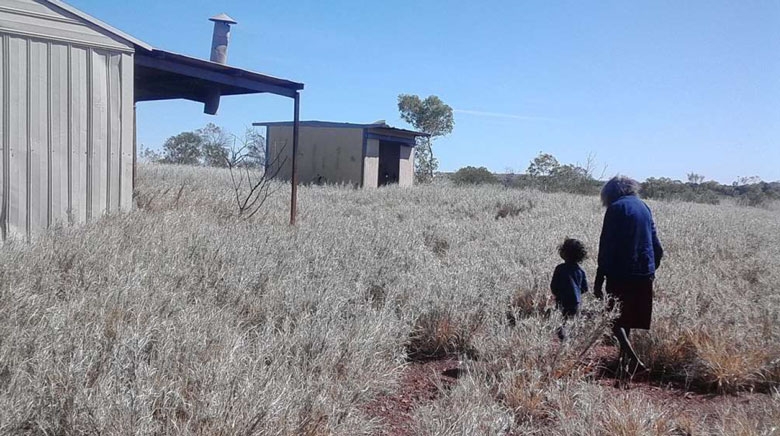The housing half of holistic health
Anyinginyi Health Aboriginal Corporation was a partner in research that confirms housing remains a fundamental building block for good health.

Elder and child in a community near Tennant Creek. Photo by Patricia Nururla Frank.
Tennant Creek, Northern Territory: Anyinginyi Health Aboriginal Corporation has contributed to a study of a major factor underlying many of the health issues facing Aboriginal people in and around Tennant Creek: insufficient and poorly maintained public housing and lack of affordable alternatives.
As the below diagram and accompanying text show, Anyinginyi takes a holistic approach to health, striving for best practice in both health care and cultural respect.

Holistic health care
Anyinginyi Health takes a community development approach to primary health care. Aboriginal people have the right to affordable, accessible and appropriate health care, and that means factoring in social and environmental circumstances, as well as working to promote public health and wellbeing. All those elements help to build community capacity and to empower Aboriginal individuals, families and community to accept self-responsibility for health and wellbeing.
The three components of family, community and culture are integral to good health outcomes.
In a holistic approach to good health and wellbeing, culture and cultural authority play a strong role. The model respects the diverse cultural leadership structures and cultural identities of Aboriginal people, families and clients. Culture is the foundation and the principle of cultural responsiveness flows through the design and implementation of the service.
This is how we do business.
It may be true to say that every Aboriginal community-controlled health service is pulled in multiple directions, to treat clients’ existing conditions, provide healing and preventive programs, develop and maintain relationships with external stakeholders (including funding bodies) and advocate for the sector and the communities in its region. Participating in research is yet one more activity on an already-crowded schedule, and given the sensitivities around personal health information, it’s easy to imagine that research would be the last activity adopted, and the first to drop off when resources are stretched. But when Professor Paul Memmott from the University of Queensland—who has engaged with the corporation since 2007—approached to dscuss a multidisciplinary exploration of the relationships between health and housing, Anyinginyi recognised the strength of the project’s links to its core business.
Anyinginyi directors and managers are well aware that poor housing contributes to poor health. One of the corporation’s six strategic priorities (along with ‘strong governance and leadership’) is ‘tackling Aboriginal disadvantage’—and ‘poor housing’ is the first item on that agenda. So in that sense, it was worth the investment of time to meet with the researchers, compile and supply two years’ worth of diagnostic data, participate in interviews and review the findings. As the directors said:
We have a vision of good health for the people of the Barkly region. We know the living conditions for our people are bad, but it helps to know exactly how bad, how far we need to go to achieve our vision. So this research is high-value for us.
The research report—Pilyii Papulu Purrukaj-ji (good housing to prevent sickness)—is unsurprising but actionable: solid evidence and a powerful case for investment in more housing and better maintenance. One of the project’s most significant findings is that overcrowding in bush communities and in town is worse than officially recorded, with an average of 7.3 people per house in bush communities, and 10.8 in town. Crowded houses mean a much greater likelihood that the washing machine will break or the toilet will block—and as we all now know (thanks and no thanks to COVID-19), without functioning facilities to wash, it’s much, much harder to stay healthy.
The researchers found high rates of preventable hygiene-related infectious diseases, over half of which were infections of the skin, ear, nose and throat. It seems clear that inadequate housing is the source of much of the infectious disease, as the report says: ‘the fundamental cause of the high rates of preventable infections is crowding’.
These problems are chronic but with culturally appropriate resourcing they are solvable—so we hope to see action on that front. In the mean time we congratulate Anyinginyi and the Aboriginal community-controlled health sector in general for their deep commitment to holistic health.
This article by the researchers provides further information on the study.